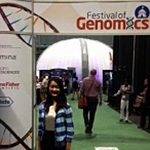My Takeaways from the First-Ever Festival of Genomics
By Wendy Ma
I recently had the amazing opportunity to go to the first-ever Festival of Genomics, which took place June 23 and 24 at the Boston Convention Center, a few blocks away from Kerafast’s office in downtown Boston.
As the blueprint of life, genes direct cell function by encoding for the creation of proteins. Genetic information is key to diagnosing, treating, preventing and curing many illnesses. The Festival of Genomics served as a forum for those in academic institutions, healthcare organizations, biotechnology companies and the pharmaceutical industry to meet and discuss their work in the genetic field.
What happened at the festival?
- Pioneers in the field of genomics such as Craig Venter, George Church, Eric Green, Jimmy Lin, James Lupski, Robert Green and Jonathan Bingham gave TED-style talks.
- The festival focused on 8 main themes: genomic medicine, long read sequencing, translational epigenetics, rare diseases, cancer genomics, genome data analysis, practical clinical implementation and pharmacogenomics.
There were so many great speakers, presentations, panels and discussions, it’s impossible to talk about all of them. Instead, I will reflect on four that I found especially interesting.
Studying environmental contributions to human disease via epigenetics
Brian R. O’Connor, Assistant Professor and Scientific Director of Genomics, National Jewish Heath and University of Colorado
It is often misconceived that your genes determine all of your characteristics. However, through studying epigenetics it has been found that external or environmental factors can affect how a cell reads genetic information by switching genes on and off, influencing your characteristics. In this talk, Dr. O’Connor focused on his experience with respiratory diseases in illustrating the effects of different environments on identical twins. He found that the environmental factors influenced histone modifications which could be biomarkers of disease and potentially used as a prediction method.
Whole human genome analysis
Mark Gerstein, Professor of Biomedical Informatics, Yale University
The discovery of pseudogenes in the whole genome gives us insight on our history as a species and provides explanations of certain diseases. This talk explored potential reasons for the existence of these “dead” or noncoding regions on the genome, since coding exons comprise only two percent of the whole genome sequence. For example, some pseudogenes have been found to be functional as RNA even if the produced protein is nonfunctional. By comparing these noncoding regions among different organisms, we can see how organisms have adapted to survive.
Women lead the way: genomic sequencing and the transformation of prenatal care
Diana W. Bianchi, Professor of Pediatrics, Obstetrics and Gynecology, Tufts University School of Medicine
Genetic diagnosing using maternal and placenta blood allows for non-invasive diagnosis of potential genetic issues with fetuses. It is a very good screening test for trisomy 21, 18, 13 and the sex chromosomes. In high-risk pregnant woman (aged 35+), it is 99.2% accurate at screening Down Syndrome with a 0.09% false-positive rate. This new technology has transformed prenatal care drastically in three years, and the eventual goal is to treat fetuses with genetic conditions as early as possible in the womb to lessen the effects of developmental issues associated with the condition.
Big (genomics) data: moving to a new paradigm in bioinformatics computing and data analysis.
Jonathan Bingham, Product Manager, Google Genomics
As scientists overcome the challenge of DNA sequence production, data analysis and management becomes the new bottleneck. Google launched Google Genomics to “help the life science community organize the world’s genomic information and make it accessible and useful.” This database of genetic information can be used to analyze the commonality of a gene in different diseases and eventually formulate a screening test for a variety of diseases that one could potentially develop. The project is a unique combination of two different industries working together to further advance science.
Another talk I found particularly fascinating was a panel discussion on the ethical, social, political and legal implications impacting the adoption of genomics in healthcare. I’ll be covering this topic more in-depth in a future blog post – stay tuned!



